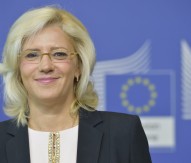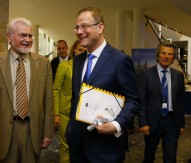
Analysis… Route innovation
EIT Governing Board chairman Peter Olesen spoke to Portal at INNOVEIT 2015 in Budapest, Hungary, on how the organisation will create new KICs in 2016, despite expected cuts from the Junker Investment Plan.
The European Institute of Innovation and Technology (EIT) is the EU’s independent innovation venture. Established in 2008 with the goals of bringing more new products and services from lab to market, spurring entrepreneurship across Europe, encouraging sustainable economic growth and competitiveness, and strengthening the innovation capacity of EU member states, the organisation realises these ambitions through the knowledge triangle of higher education, research and business.
Through this concept, the EIT has created three Knowledge and Innovation Communities (KIC) in the sectors of future ICT, climate mitigation and adaptation, and sustainable energy, to meet today’s societal challenges.
Horizon 2020
The EIT draws its funding from the EU’s research and framework programme, forming an integral part of Horizon 2020. Over seven years, the independent body of the EU has been allocated funding worth just over €2.7bn, and the organisation also ‘strongly contributes’ to meeting the aims of Horizon 2020, in particular the Societal Challenges.
During the course of the R&I programme, the EIT is launching five new KICs to help address these grand challenges. The winners of the first two KICs in the areas of ‘Innovation for healthy living and active ageing’ and ‘Raw materials – sustainable exploration, extraction, processing, recycling and substitution’ were announced in December 2014, and rapid progress has already been made in establishing the first core attributes.
EIT Health and EIT Raw Materials will be joined by two further KICs in 2016, under the banners of ‘Food4Future – sustainable supply chain from resources to consumers’ and ‘Added value manufacturing’; the calls for consortia to run the new KICs are set to take place later this year. In 2018, a further KIC is expected to be launched in the area of ‘Urban mobility’.
In addition to the KICs, another core instrument of the EIT is the Regional Innovation Scheme (RIS). According to the organisation, ‘The EIT RIS is a structured outreach scheme to support the integration of the knowledge triangle and increase the innovation capacity in areas and regions in Europe not directly benefitting from the EIT and its KICs. It is based on a two-way engagement between KICs and selected partnerships from the wider European innovation community.’
The RIS is based on the principles of ‘thematic alignment’, ‘openness and transparency’, ‘excellence’ through the inclusion of ‘leading higher education institutions, research organisations and businesses’, and ‘voluntary and autonomous implementation by KICs’.

Peter Olesen says that the EIT is “confirming the old story” that powerful innovations are eventually realised © European Institute of Innovation and Technology
New conference
This year, the EIT announced a new conference combining four traditionally separate organisation events. INNOVEIT 2015 brought together high representatives of each of the current five KICs, senior members of the EIT, the European Commissioner responsible for the institute, Tibor Navracsics, and EIT alumni. The three-day event also encompassed the annual EIT Awards, which recognise and reward the successful start-ups, innovative projects and young entrepreneurial talent in Europe today.
In May, Portal travelled to the Hungarian capital of Budapest to attend the conference. Following the announcement of this year’s EIT Award winners, Portal sat down with chairman of the institute’s Governing Board Peter Olesen and discussed this year’s champions, the establishment of the next KICs, the impact of the cuts to the EIT’s budget, and encouraging the growth of entrepreneurship in Europe.
What is your reaction to this year’s EIT Award winners?
If you compare this year’s EIT Awards ceremony with 2013 in terms of the number of nominees and the innovations presented, there has been a real upward trend. The ideas are close to market, which is very satisfying. This is the whole idea: to have impact and create new jobs.
None of the three winners came from EIT Digital – is this a poor reflection on the KIC?
No, not at all. If you look over several consecutive awards ceremonies, you would probably see an averaging out between the three KICs. In any case, competition is healthy and spurs great innovations, so we are hoping that the EIT Awards will continue to do that.
What are the major aims of the EIT over the next 12 months?
We are now embarking on the expansion of both EIT and KIC activities in Europe and to countries and organisations that are not part of EIT KICs today. We are focusing on sharing learning and good practices, making entrepreneurial education, incubators and business accelerators available to others, and that is the role that the EIT RIS is playing. EIT-labelled entrepreneurial education is a unique EIT feature, and that is what we need.
We are also focusing on sustainable growth and creating KICs in additional areas of societal challenges, complementing the picture across Europe. We are already preparing the next EIT call for two new KICs: one in the area of added value manufacturing and one in the area of food for the future; this call will be launched early in 2016.
Finally, we are also looking at the long term structure and function of the EIT and the KICs, and that is related to the issue of what we call financial sustainability of the KICs. The EIT investment guarantee ensures funding for the first seven years, with the possibility of extending it further. Over a period of seven to 15 years, we support and incentivise the KICs financially to ensure they have a strategy in place on how to substitute EIT investment with either external funding or financing from themselves. This is a key focus right now.
How would you assess the achievements of the three established KICs?
We are confirming the old story – good, innovative things take time, including when working on completely new grounds with public systems and all applicable rules of finance and governance. As an EU body, we are accountable to the EU citizen. This includes a substantial number of control measures that have to be complied with. When you have the structure in place, you also have to ensure that all the governance issues regarding the allocation of grants and reporting are set up, too.
The activities presented at this year’s EIT Virtual City Tour include more than 20 specific project activities run by the KICs and the EIT Awards nominees; they are great ideas, ventures and projects, many of which are already on the market. The whole idea of this innovation conference is to showcase what we are doing and make the EIT and the KICs more visible to the wider innovation community.
Are there any particular traits you are looking for in the new KIC proposals?
Instead of having up to six co-location centres, we suggest starting with five at the proposal stage and focusing on up to 50 core participants at the beginning, before growing. This is part of the lessons learnt exercise we conducted and the expert input we have received on the 2014 call. By reducing the number of participants at the proposal stage (and only then), we can get a quicker start and a much stronger partnership.
We can see from the first three KICs that there is growth in the number of participants and the number of co-location centres – we want to have a smaller start and then grow as that fits the pattern much better.
An EIT call for KIC proposals will be issued in early 2016, including an information day in the spring. A deadline will be set later next year, after which we will have a simplified review process compared to those previously held. We will have the designation of the two new KICs at the end of 2016, meaning they can start setting up in January 2017. We have learnt many lessons since the last call, which was very well organised and very successful, and we want to further stress these positive aspects and strive for further simplification.
To what extent will the EFSI cuts hamper the great innovation witnessed at INNOVEIT 2015?
If we have to live with the full impact of a 13% cut until 2020, then it will dramatically reduce the activities in the existing five KICs. This will lead to less innovation, fewer new ventures, and will support fewer new entrepreneurial students.
Yet, there may be some opportunities as we are pushed to look for other ways of funding and are challenged to ensure impact through delivery. We can attract external funding or supplemental external risk capital for the most promising new ventures coming out of our incubators because, at a certain time, they need external capital to really take off, and we cannot do that with the limited funds we have at the EIT.
We need more risky money, and this situation with the budget may force us to sort of speed up that process and be more creative in looking for funding or investment possibilities.
What are the greatest barriers to the growth of entrepreneurship in Europe?
Firstly, the whole culture around entre-preneurship. We have seen a dramatic change over the last five to ten years, and the EIT has been part of that change, but we still have this old-fashioned culture of not having a common European entrepreneurial spirit.
Secondly, it is not necessarily the lack of investment for early stage entrepreneurship (we have money locally, regionally, nationally and through incubators, and we are building the EIT KIC ecosystem); the real barrier is when we start to produce more outcomes from our activities and try to scale up. The money needed for scale up is huge, and that means early venture capital and investment.
What steps can the EIT take to change the culture and encourage more risky investments?
This is what we are embarking on now, and we are discussing other ways of seeking partners, private investors and public private funding; we are making ourselves more attractive towards the venture capital environment. We have to make ourselves more attractive, and that comes back to seeing innovation come to fruition, which we are seeing today.
Peter Olesen
European Institute of Innovation and Technology
This article first appeared in the seventh edition of Horizon 2020 Projects: Portal, which is now available here.




